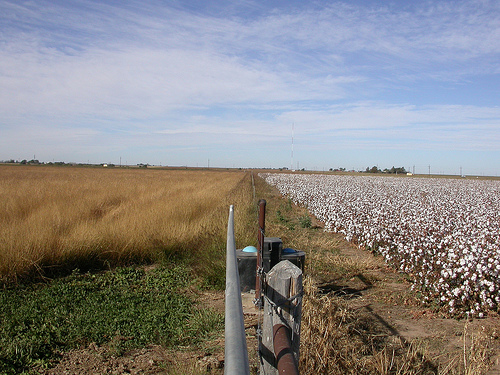How ‘Eco’ is Friendly to Agriculture and Food Systems

Grass and cotton fields in the Texas High Plains study. Credit: Vivien Allen (Texas Tech University).
This post is part of the Science Tuesday feature series on the USDA blog. Check back each week as we showcase stories and news from USDA’s rich science and research profile.
Words like eco-friendly, green, fair, climate-friendly, community-based and organic are popping up daily – in the news, in ads and labels, and in conversations ranging from kitchen tables to international conferences. All of these and more come under the umbrella of sustainability, which people often describe as caring for people, planet and proceeds all at the same time.
But how is the sustainability idea being applied in food and agriculture, and what is USDA Science doing to help?
Sustainability in agriculture means improving water and energy efficiency and better use of other natural and human resources on farms and ranches and in the food system. Although novel to many, less widely-practiced systems such as agroforestry and perennial grains are other approaches to creating a more productive, sustainable way to farm.
The USDA’s Office of the Chief Scientist white paper on sustainable agricultural systems describes our science strategies in this area. Here are a few examples of what we’re doing:
- Helping farmers continue to reduce their water and energy use by, for example, providing the scientific knowledge to successfully integrate pastures into cotton production systems in the High Plains of Texas, leading to an integrated crop/livestock system that needs 23 percent less irrigation water and 40 percent less purchased nitrogen fertilizer than traditional systems.
- Studying how organic farming systems compare to other approaches to farming and fostering the exchange and sharing of results with researchers and farmers
- Helping farmers, ranchers, and communities tap the potential of local and regional food systems, as part of the USDA Know Your Farmer, Know Your Food initiative – and working with USDA’s geospatial team and others across USDA to put food system projects into a handy interactive map so you can find what’s happening in and around your own community
A big challenge in sustainability science is understanding how individual practices or research results fit together into systems that address the multiple goals of sustainability – people, planet and proceeds. One approach is life cycle assessment, where impacts such as water and energy use are tallied up for a product from cradle to grave. In food systems, cradle to grave would include the inputs to farming such as fertilizer, then what happens on the farm, then processing and transporting to the market, getting the food to your home and then to your plate, and even what happens to the waste.
Trying to keep track of all of the impacts of all of those steps boggles the mind! USDA’s National Agricultural Library is coming to the rescue by developing the “LCA Digital Commons.” We are filling the Commons with agricultural data from ongoing surveys of the National Agricultural Statistics Service (NASS) and the Economic Research Service (ERS) along with experimental data from projects conducted by the Agricultural Research Service (ARS) or funded by the National Institute of Food and Agriculture (NIFA).

Applying sustainability to agriculture and food systems is like applying lipstick to a pig. The pig is still a pig. Likewise, our agriculture and food systems are still not sustainable by any metric. One metric is the subsidy appropriated in an attempt to sustain the system, with the 2012 farm bill being one such subsidy. So to determine a sustainable system, drop the subsidies. The emerging self sufficient system would suggest a sustainable agriculture and food system. Now that would be a fruitful study for sustainability science.